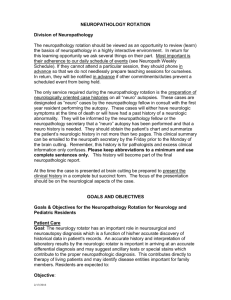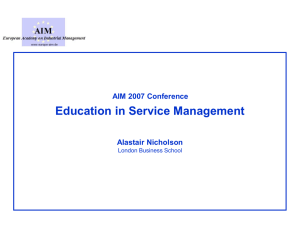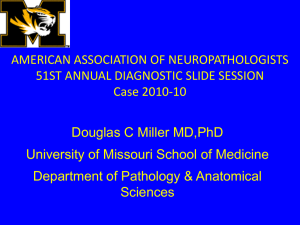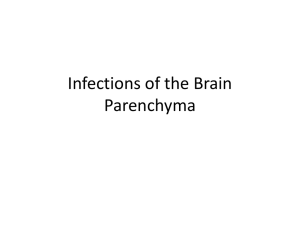Bacterial Infections of the CNS
advertisement
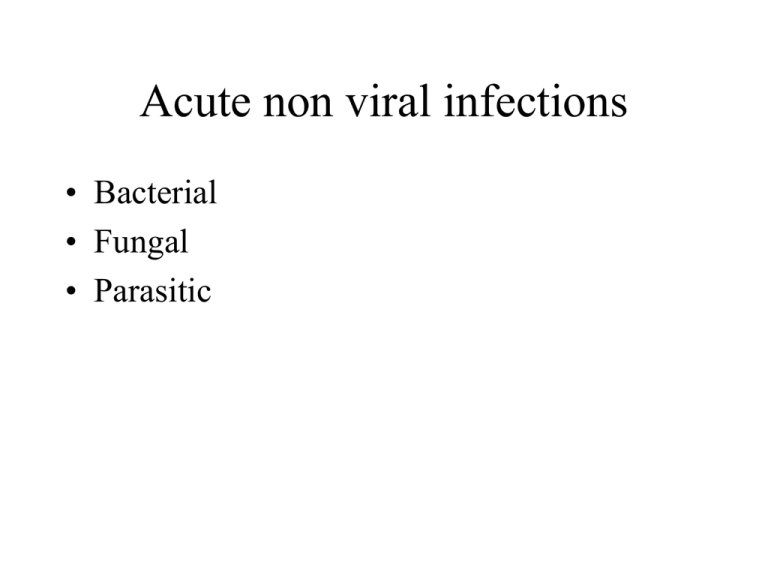
Acute non viral infections • Bacterial • Fungal • Parasitic Bacterial Infections of the CNS • Neonatal bacterial meningitis – Common organisms • Gram negative bacilli • Streptococci – 30-60% mortality – Significant long-term morbidity 35% Common etiologic agents of bacterial meningitis • Most common – Neisseria meningitidis – Group B Streptococcus • Other Gram Positive – Listeria monocytogenes – Staphylococcus aureus • Other Gram Negative – – – – – – E. Coli Citrobacter Klebsiella Pseudomonas Proteus Salmonella Bacterial meningitis: Gross findings • Edematous brain +/herniation • Hemorrhage and infarction • Opacity of meninges – Subdural empyema • Ventriculitis • Obstructive hydrocephalus From: Neuropathology Illustrated 1.0 From: Neuropathology Illustrated 1.0 Meningitis Pus Vessels cuffed by leukocytes Skull Empyema From: Neuropathology Illustrated 1.0 Bacterial meningitis: Microscopic findings • Meningeal infiltrate with abundant neutrophils macrophages, fibrin and cell debris • Extension into the VirchowRobin space • Vascular thrombosis and infarction (more common in neonates) From: Neuropathology Illustrated 1.0 Brain Abscess: Clinical • Increasing CNS pressure + localizing signs • If direct spread: frontal or temporal lobes • Hematogenous spread: gray-white junction • 50% morbidity – 20% mortality Brain Abscess: Pathogenesis • Half result from direct spread from sinus – Etiology • Streptococcus, Bacteroides, Actinomyces, aerobic gram negative bacilli • 25% result from hematogenous spread – Children with congenital heart defects – Adults lung abcess or endocarditis • Streptococcus – Etiologies: • Toxoplasma, Nocardia, Listeria, Gram negative bacilli, mycobacteria, fungi CT: Ring enhancing mass Well encapsulated abscess From: Neuropathology Illustrated 1.0 From: Neuropathology Illustrated 1.0 Brain Abscess: Microscopic progression • 1-2 days: suppurative encephalitis • 2-7 days: focal encephalitis with central necrosis • 5-14 days: early encapsulation From: Neuropathology Illustrated 1.0 Epidural abscess • • • • Mostly in spinal canal Biconvex shape on MRI Direct extension most common Staphylococcus aureus Tuberculosis meningitis • Diffuse symptoms over 2-3 weeks – Later cranial nerves involved or increased CSF pressure – Decreased glucose and increased protein – PCR of CSF is diagnostic • Gelatinous subarachnoid exudate – Sylvian fissure and base of brain – +/- tubercles with focal findings • Abundant macropahges and necrotizing granuloma Tuberculosis meningitis Fite stained mycobacteria Leptomeningeal inflammation From: Neuropathology Illustrated 1.0 Syphilis • Asymptomatic CNS involvement – CSF pleocytosis • Meningitis – 1-2 years post primary infection – Rarely symptomatic • Meningovascular syphilis – Peak incidence 7 years post primary infection – Chronic meningitis and multifocal arteritis • Parenchymatous neurosyphilis and Tabes Dorsalis – Peak incidence 10-20 years after initial infection – General paresis of the insane • Gummatous neurosyphilis Parenchymatous neurosyphilis Chronic infarcts secondary to end-arteritis From: Neuropathology Illustrated 1.0 Plasmacytic infiltrate Spirochetes Lyme Disease • Borrelia burgdorferi • Stage 1: Days to weeks – Maculopapular rash • Stage 2: Weeks to months – Meningitis with cranial nerve palsies • Stage 3: Months to years – Axonopathy, encephalopathy, polyarthritis Fungal Infections of the CNS • Usually associated with immunosuppression • Mostly hematogenous dissemination – Rare direct extension (mucormycosis) • Yeasts - Leptomeningitis • Hyphae - Hemorrhagic infarcts From: Neuropathology Illustrated 1.0 Aspergillosis • Airborne spores from soil – Hemtogenous from lung – Direct extension from paranasal sinuses • Necrotizing angiitis • Usually CSF without detectable bug Aspergillosis H&E Branched Hyphae From: Neuropathology Illustrated 1.0 Grocott Stain Mucormycosis • Most common form: Rhinocerebral – Direct extension from sinuses – Poorly controlled diabetic • Hematogenous dissemination of Mucor is less common but usually from lung Broad Hyphae Early Abscess From: Neuropathology Illustrated 1.0 Cryptococcosis • Primary infection is usually pulmonary • Meningitis versus abscess – Dilation of Virchow-Robin Space From: Neuropathology Illustrated 1.0 Cryptococcosis • Encapsulated organism • Stains with PAS & Mucicarmine Encapsulated organisms From: Neuropathology Illustrated 1.0 Candidiasis • Usually systemic nidus – Intestinal overgrowth secondary to antibiotics – Catheterization or surgery • Seldom in immunologically intact • Microabcesses with hematogenous dissemination Grocott Pseudo Hyphae From: Neuropathology Illustrated 1.0 Coccidioidomycosis or Histoplasmosis • Soil organisms • Inhaltion leades to primary pulmonary nidus – Pregnancy, diabetes or other immunosuppression Encapsulated 50 micron cyst From: Neuropathology Illustrated 1.0 Parasitic Infections • Amebic Infections – Cerebral amebic abscess – Primary amebic meningoencephalitis – Granulomatous amebic encephalitis Cerebral amebic abscess • Entamoeba histolytica – – – – Common intestinal parasite CNS abscess is rare and late complication Hematogenous dissemination of trophozoites Trophozoites identifiable in abscess wall Primary amebic meningoencephalitis • In immunocompetent host, etiologic agent – Naegleria fowleri – Ubiquitous environmental contaminant that seeds nasal passages • Follows swimming in fresh water – Ascends into CNS through cribiform plate – Acute fulminant presentation with death in 72 hours From: Neuropathology Illustrated 1.0 Amoebic Encephalitis Hemorrhagic encephalitis Nucleated amoebae From: Neuropathology Illustrated 1.0 Granulomatous amebic encephalitis • In immunocompromised host – Acanthamoeba or Balamuthia madrillaris • Hematogenous dissemination into CNS from lower respiratory tract or skin – Subacute or chronic disease • Focal deficits or seizures • Usually fatal Cerebral Malaria Any of four species of malaria 1-10% of P. falciparum have CNS involvement – Usually in children – Incubation period 1-3 weeks – Clinical presentation secondary to increased intracerebral pressure Blood vessel with infected RBCs Pathogenesis – Occlusion of CNS capillaries by infected RBCs – Mortality 20-50% From: Neuropathology From:Illustrated Neuropathology 1.0 Illustrated 1.0 Cerebral Toxoplasmosis: Postnatally-acquired • Definitive host is cat • Infection of immunocompetent human is asymptomatic – High seropositivity (20-40% in US) • CNS disease associated with compromised cell mediated immunity • Ring enhancing lesions • Pathology: – Necrotizing abscesses with coagulative necrosis and PMNs Cerebral Toxoplasmosis CT Multiple abscesses Basal ganglia abscess From: Neuropathology Illustrated 1.0 H&E Tachyzoites Toxoplasmosis From: Neuropathology Illustrated 1.0 Immunostained Tachyzoites From: Neuropathology Illustrated 1.0 Cerebral Toxoplasmosis: Congenital • Only a minority of cases show classical triad – hydrocephalus, calcifications and chorioretinits • Results from transplacental spread in primary maternal infection • Pathology – Multifocal necrosis • Periventricular and sub-pial • tachyzoites – Microcephaly Cysticercosis • Commonest parasitic infection of CNS – Larval form of pork tapeworm Taenia solium – Humans are usually definitive host – Pig intermediate host • Cysts = Cysticerci most commonly in muscle – 1-2 cm in diameter with single scolex – Calcifies Cysticercosis MRI Multiple cysts From: Neuropathology Illustrated 1.0 H&E Scolex From: Neuropathology Illustrated 1.0 Schistosomiasis • Man definitive host – Adult schistosomes inhabit blood vessels – Large numbers of ova in blood • CNS involvement rare – Retrograde passage of ova though pelvic veins – Spinal cord involvement From: Neuropathology Illustrated 1.0



